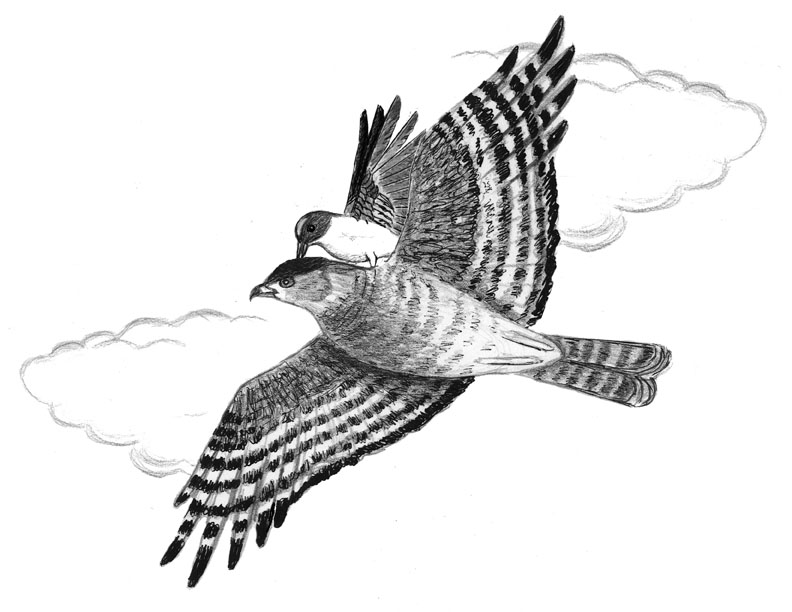
Dear Bird Folks,
For the first time ever, we have a pair of Eastern Kingbirds in our yard. Do you think they’re just passing through or might they be nesting nearby? Also, what can I do to keep them around?
– Paul, Sudbury, MA
Let me check my calendar, Paul,
A quick glance at my calendar, which believe it or not has pictures of birds on it, tells me that it’s now the middle of June. That means the season for birds to be “just passing through” is basically over. Spring migration, which ironically begins long before spring (hummingbirds start heading north in February), has finally come to an end. Now it’s time for birds to do what they have traveled all this way to do…make more birds. The surprise visitors that some of us saw in May (grosbeaks, buntings, tanagers) have by now moved on to where they should have been in the first place. Whatever birds you are seeing in your yard today, including Eastern Kingbirds, are very likely nesting in the area. And if there is a nest of kingbirds nearby, you should get ready for the show. What show is that, you ask? Oh, you’ll see.
For years, some people (you know who you are) have called Blue Jays “the mean birds.” This is because jays can be a bit bossy, but jays are saintly when compared to kingbirds. Birds tend to be hostile to others of the same species during the breeding season. For example, chickadees will clash with other chickadees and cardinals will squabble with neighboring cardinals if they cross territorial borders. But kingbirds not only fight with other kingbirds, they’ll fight with any bird and I do mean any bird. Do they attack grackles? Yup. What about crows? Yes, crows, too. How about hawks? Sure, bring ‘em on. Even Blue Jays have been literally knocked off tree branches by an upset kingbird. Now who’s the mean bird?
Dark on the back, white on the front, with white tips on the tail, the Eastern Kingbird is typically seen sitting on the very top of a tree or post. Many species of birds feel safer remaining hidden in dense thickets, but the fearless kingbird prefers to be right out in the open. Sitting up high allows these flycatchers to not only locate and catch any passing insects, but they can also spot and attack any birds they don’t like. And which birds don’t they like? The answer is, all of them.
You might think that a creature this pugnacious would be fairly large and muscular, looking like a product of Gold’s Gym. But kingbirds are surprisingly small, only about the size of a catbird. In addition, unlike those loudmouthed jays, kingbirds have wimpy little voices, sounding more like insects than intimidators. So, how does a small bird with an even smaller voice get away with attacking hawks and knocking over Blue Jays? It’s all in the attitude. Just ask The Fonz. For those who don’t know, or remember, The Fonz was an imposing character on a ‘70s TV sitcom. Surprisingly, Henry Winkler, the actor who played Fonzie, was only 5’6” and 130 lbs, but no one ever noticed. Why? It’s because whenever Arthur Fonzarelli entered a room, his assertive demeanor commanded immediate respect. That’s how it works with kingbirds. They act tough; therefore, all the other birds simply assume they are tough, just like The Fonz. (Although as far as I know, no kingbird has ever tried to jump over a shark while riding a motorcycle.)
The name of the Eastern Kingbird implies that this is a bird of the eastern part of North America, but as we all know, common bird names often lack accuracy. In fact, Eastern Kingbirds breed from Maine to Oregon, and just about everywhere in between. Not to take anything away from your sighting, Paul, but according to Mass Audubon’s latest breeding bird report, kingbirds are considered to be “nearly ubiquitous” in the state. Each summer, just about every town has at least one and probably several pairs of nesting kingbirds; yet, backyard bird watchers often overlook them. This is because kingbirds don’t come to feeders, or use birdhouses or even drink from birdbaths. (Due to their diet of moisture-filled insects, kingbirds have rarely been seen drinking water from a birdbath or from anything else.) You’d think folks would at least notice when kingbirds are attacking hawks, but the belligerent birds are mostly dark and nondescript. Everyone probably assumes the little bird chasing after the big hawk is just a psycho starling or grackle and lets it go at that.
What’s interesting about kingbirds is that their aggression towards each other changes once the breeding season is over. On their wintering grounds in South America, kingbirds spend their days in sociable flocks, peacefully feeding on fruit instead of insects. That’s right. These super-aggressive birds quickly become friendly and pleasant the minute they stop being carnivorous and switch to a vegetarian diet. Maybe we could learn something from that. I’m just saying.
I’m glad you have kingbirds in your yard, Paul, but in terms of feeders, food or water, there isn’t much you can offer them, except to keep your yard as natural as possible. Unfortunately, too many people spray toxins on their plants, which eliminates the insects the birds depend upon. Never spray. If your neighbors suggest you do it, just look them in the eye and tell them to “sit on it.” The kingbirds will benefit and The Fonz will be proud.